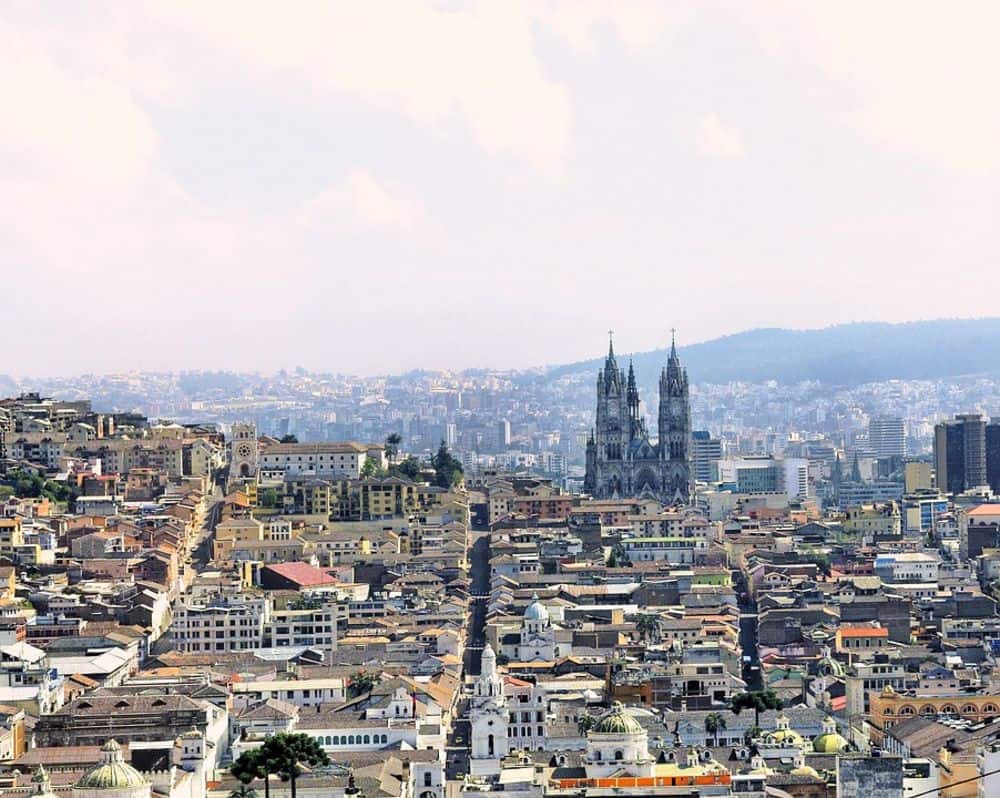Ecuador or the Republic of the Equator is located on the western coast of South America between Colombia and Peru. As the name suggests, the country lies on the equator, where it draws its name.
Numerous tourists flock the country year in year out and for very good reasons; you cannot exhaust your list of things to do here. To give you a peek, think of a jungle, Islands, highlands, World Heritage sites, diverse animal and plant life, and an extensive coast, all within the borders of one country.
As you will realize, Ecuadorian cities and towns are delights for travelers on their own. To give you a clearer picture, I have compiled a list of the largest cities in Ecuador by population and summarized why each deserves a visit.
What are the Largest Cities in Ecuador? The largest cities in Equador are Guayaquil, Quito, Cuenca, Santo Domingo de los Colorados, Machala, Manta, Portoviejo, Duran (Eloy Alfaro), Esmeraldas, and Ambato.
1. Guayaquil

Guayaquil is the biggest city in Ecuador and it’s the country’s main port. About 2.7 million people live in the city, with its metropolitan region hosting over 3.1 million people. It is situated along the banks of river Guayas, a 241 mile-long river that is a national symbol.
The city was founded in 1538 by a Spanish conqueror and has ever since remained an important entry point for European visitors.
If you want to experience Ecuador’s culture, food, and history, Guayaquil is the place to visit. A good spot to start is Parque Seminario, a historic park in downtown Guayaquil.
The park is also just next to the magnificent, La Catedral, a Catholic church and city icon. Another must-visit spot is the 1 ½ mile-long Malecón 2000, a boardwalk with historical monuments, museums, fountains, malls, restaurants, and a movie theater.
2. Quito

Among the largest cities in Ecuador, Quito is the capital and second-largest after Guayaquil.
Quito was named the first UNESCO World Heritage site In the world. At an elevation of 9,350 ft, this is the highest capital city in the world. Sucre, the capital of Bolivia comes second at 9,214 ft above the sea level.
Another interesting fact is that Quito is the capital city closest to the Equator. It hosts numerous historic churches, preserved colonial streets, museums, and parks.
If you are a hiker, the city is located on the slopes of Pichincha, a 15,696 ft mountain- with many hiking trails. Otherwise, you can ride the exhilarating sky tram.
Catholic pilgrims visit to hike the 9,895 ft-high El Panecillo Mountain. Located just outside Quito city, the mountain hosts a 135 ft-tall monument of a madonna (statue of the Virgin Mary).
3. Cuenca

Cuenca, with about 400,000 inhabitants, is located in Ecuador’s highlands. It is the capital of Azuay Province, where the famous Cajas National Park is located.
Right at the city center are many historical buildings listed as UNESCO World Heritage Sites.
Be sure to tour the Hanging Houses- medieval buildings constructed right by the side of steep cliffs. To get to the houses, you can choose to walk along a 16th-century San Pablo footbridge.
Cuenca is also home to a 12th-century cathedral decorated with high altars and colorful arches and the Túnel Alfonso VIII-tunnels used for shelter during the Spanish Civil War.
The Paleontological Museum with lots of dinosaur exhibits and replicas of extinct species should be on your itinerary. Here, you can see models of wooly rhinoceros and saber-toothed tigers.
4. Santo Domingo de los Colorados

Santo Domingo is among the biggest cities in Ecuador. With about 500,000 people, it is the fourth largest city in Ecuador. The city is a key commercial and industrial center. It lies between Quito and the Pacific Ocean, which makes it a great stopping point during cross-country travel or when backpacking.
One of the top things to do in the city is touring Jardín Botánico La Carolina, scenic botanical gardens, where you can go birdwatching and explore many varieties of plant species.
For more nature walks, you can tackle the trails at Tinalandia lodge just a few minutes drive from Santo Domingo. If hiking through plantations is your thing, there are plenty of coffee, cocoa, banana, vanilla, and citrus fruit plantations to explore.
The city is also home to the Tsáchila, one of the fewest and indigenous tribes of Central American. There are tours to their homes where you can learn more about their traditional medicine, cuisine, and culture.
5. Machala

Machala is a city located in south-west Ecuador, near the Gulf of Guayaquil. The city is the center of El Oro Province, a region known for agriculture industries.
If you haven’t seen banana plantations beyond where eyes can see, you need to add visiting Machala to your to-do list. The banana plantations are so large, that the city is known as the “Banana Capital of the World”.
Machala’s green landscape and proximity to beaches on the Pacific makes it a great place to visit. At the Jambeli Beach, you can bask in the sand, swim or take a boat tour through the mangroves.
For more intrigue, visit the petrified forest of Punyango which is south of Machala, where numerous plants lie fossilized and spread out across the landscape.
Interesting Fact: The first time that airborne troops were involved in combat in the Americas (North, Central, and South America) was in Puerto Bolivar, Machala. This was during the Ecuadorian-Peruvian war for the port city.
6. Manta

This is the place to get that special beach vibe. Why? Some of the best beaches in Ecuador- San Lorenzo, El Murciélago, and Santa Marianita- are in Manta.
Being the home of Ecuador’s largest seaport port, Manta is a popular stop-over for many cruise ships all-year-round.
Which is your favorite seafood? You will probably eat it fresh here and while at it, get some tuna soup right at its place of origin. Water sports such as surfing, bodyboarding, kite-surfing, and fishing are also very popular in Manta.
When you want to stroll, eat or party away, there are shops, restaurants, and bars just on the El Murciélago beachfront.
To explore wildlife right at its home, head to the Pacoche Reserve and don’t forget to learn some history at the Centra Bank Museum right at the heart of Manta.
Fun Fact:
The popular Panama hat has nothing to do with Panama; its original home is in Montecristi, a small town in Manta.
7. Portoviejo

This is a coastal city named after the Portoviejo River Valley. The river valley is an agricultural powerhouse for fruits, vegetables, and other crops.
The convergence of River Portoviejo and the Pacific is home to a mangrove swamp, marine life and numerous birds which you can view at La Boca. This also translates to delicious dishes made from fresh farm and sea products.
The city is the political and commercial center for the Manabí province. Here, you can get up close with the culture of the locals by visiting the home of their ancestors at Cerro de Hoja or visiting the Museum at Hoja Jaboncillo.
If you would like to give a high-adrenalin sport a try, paragliding is popular in this part of Ecuador. Otherwise, Crucita Beach is a great place to swim and relax.
8. Duran (Eloy Alfaro)

The two names are usually interchanged but officially, Duran is the canton while Eloy Alfaro is the capital. Duran may look overshadowed by the biggest cities in Ecuador but you have to visit the place to appreciate its beauty.
Located near the meeting point of the Daule and Babahoyo rivers, the city is connected to Ecuador’s capital, Guayaquil, by a bridge. Its nearness to the capital makes it a great place to retreat especially for a quiet getaway.
Most of Duran’s inhabitants spend the day in nearby areas working and they only come back to Duran to sleep. This is the reason why the city is referred to as the ‘dormitory town’. Other residents run local cafes and restaurants where you can interact with the locals over a cup of coffee or local delicacies.
For a closer interaction with nature, you can walk or cycle to Santay Island (Isla Santay), a recreational area between Guayaquil and Duran. Numerous birds, river crocodiles, and the Machacón ducks rule the habitat.
9. Esmeraldas

This city lies at the mouth of the Esmeraldas river on the Pacific coast. It hosts the main seaport in northwestern Ecuador and is also the seat of the Esmeraldas canton and Esmeraldas province.
An international airport, a seaport, and a great transport network make the city easy to get into and about. Combine this with sandy beaches, warm tropical weather, and amazing entertainment joints like Scala disco-bar and Sambaye club and you are set for a wonderful time in Esmeralda.
And of course, you can settle for seafood combined with other local dishes and wild meat, at the restaurants along the beach.
Are you interested in fishing? Head to the fishing village of Súa and if you can, catch the whale watching tours that run from June through September. The beaches around Súa are also less crowded – making it perfect for a quiet getaway to the beach.
10. Ambato

Seating beneath several tall mountains and on the banks of Ambato River is the city of Ambato. Among the largest cities in Ecuador, it is currently the tenth by population and it’s the capital of the province of Tungurahua.
The city was rebuilt after being destroyed by an earthquake in 1947 but has managed to swing back to a great place for travelers. Museums, serene parks, historic country homes (Quintas) and great mountain views are just some of the attractions that visitors and residents delight in.
Ambato is renowned for its fruits and flower production, hence the name ‘City of Flowers and Fruits’. If you happen to be in Ambato during the last two weeks of February, you can become part of the great Fruit and Flower Festival.
Fun Fact:
Ambato has another nickname; the ‘Land of the Three Juans’. The reason being, it is the home of Juan Montalvo, Juan León Mera, and Juan Benigno Vela, all of which have played major roles in the history and literature of Ecuador.
Final Thoughts
When you look at a country like Ecuador in general, it is possible to concentrate on the highly advertised and crowded tourist attractions and never find the less unique, and unexplored gems.
This way, you might miss out on the special vibes that can only be created by interacting closely with a certain area of interest. This summary of the largest cities in Ecuador is only a scratch on the surface; there’s so much more to discover in person.
